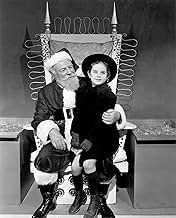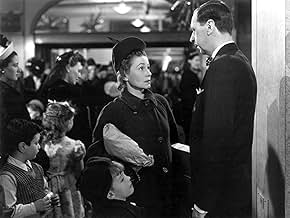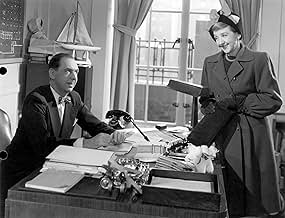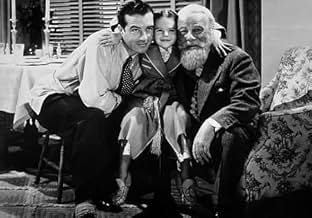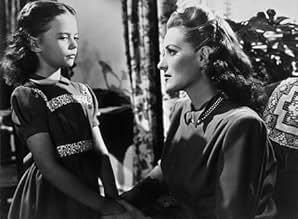VALUTAZIONE IMDb
7,9/10
58.234
LA TUA VALUTAZIONE
Quando un simpatico vecchietto sostiene di essere Babbo Natale, viene internato e considerato pazzo, un giovane avvocato decide di difenderlo.Quando un simpatico vecchietto sostiene di essere Babbo Natale, viene internato e considerato pazzo, un giovane avvocato decide di difenderlo.Quando un simpatico vecchietto sostiene di essere Babbo Natale, viene internato e considerato pazzo, un giovane avvocato decide di difenderlo.
- Regia
- Sceneggiatura
- Star
- Vincitore di 3 Oscar
- 10 vittorie e 1 candidatura in totale
Jack Albertson
- Post Office Mail Sorter Next to Lou
- (non citato nei titoli originali)
Harry Antrim
- Mr. R.H. Macy
- (non citato nei titoli originali)
Arline Bletcher
- Courtroom Spectator
- (non citato nei titoli originali)
Lela Bliss
- Mrs. Shellhammer
- (non citato nei titoli originali)
Symona Boniface
- Courtroom Spectator
- (non citato nei titoli originali)
Walden Boyle
- Judge's Clerk
- (non citato nei titoli originali)
Kevin Burke
- Child on Santa's Lap
- (non citato nei titoli originali)
Dorothy Christy
- Secretary
- (non citato nei titoli originali)
Dick Cogan
- Department Store Head
- (non citato nei titoli originali)
Recensioni in evidenza
What's wonderful about 'Miracle On 34th Street (1947)' - and this isn't something I realised until after it had finished - is that it never actually provides a definitive answer as to whether Kris Kringle really is the Santa Claus. Personally, I took it as fact from the moment he walked into frame, but I'm pretty sure that was due to my preconceptions surrounding the plot of the picture (Santa goes to court to prove his existence). Thinking back, I had no definitive reason to think that. The absolute ambiguity of the film's central dilemma is brilliant because it forces the viewer to engage with the question that's on almost every characters' lips: is this the real Santa or is it just a kind old man who thinks he's the real Santa? In turn, this allows the movie's theme of belief to transcend its boundaries and truly take root in the audience. Whether you choose to believe in Santa, whether you choose to have faith in him, whether you choose to accept the unacceptable is entirely up to you. As such, it's that much more magical if you do. It's really impressive that the picture can actually use its ambiguity to this effect, especially that it can do so while remaining wholesome and sincere throughout. This charming Christmas tale is enjoyable from beginning to end and it holds up remarkably well seventy-five years after its initial release. It's a delightful experience overall.
This is certainly a lovely warmhearted movie, but since other reviewers have described the plot in detail, I'll move on to other topics.
I love movies like this for the insight they provide into the customs of a lost era. Watch the clothing - everybody is so dressed up! - women in dresses, gloves, and hats, men in hats and suits. Notice that when O'Hara enters a room filled with Macy's executives, even though they are the bosses and she is lower management, they all stand up instantly.
The social satire, most on display in the courtroom scenes, also is very 1940s. Apparently audiences of that era took a kind of genial corruption in the judicial system in stride. Business leaders, like "Mr. Macy" were expected to be sharp and profit-oriented, but also decent people like the rest of us. It's a much more nuanced view than the "businessman as criminal villain" so common in today's movies.
The character played by Maureen O'Hara probably needs explanation for modern viewers. Late 1940s audiences knew that the social and economic situation of a divorced working woman with a child was much more precarious than it is now. Divorce was still somewhat shocking - this is brought out neatly in the movie when her would-be lover does a double take when he learns from her daughter about the divorce - he probably had assumed she was a war widow. Divorced moms were still rare in the middle classes. Society universally agreed that women should stay home to raise their children. Economically, women in management positions were still very rare, couldn't expect promotion, and were last hired, first fired. I think O'Hara's performance brings out these qualities in a way that the audience of the 1940s would have understood easily. The character's stiffness, fear of losing control, and anxiety about her job make a great deal of sense. It would have been nice to see a few scenes showing her loosening up, perhaps at dinner with her boyfriend; no doubt those got left on the cutting room floor.
I really like the scene where Santa talks to the little Dutch orphan. First, this scene also must have resonated with the audience; in 1947 the western European countries had only started to recover from World War II, and probably many Americans were familiar with the idea of adopting a war orphan, just as many sent CARE packages. Second, by making Santa fluent in Dutch, the writer cleverly left the viewer thinking that hey, he might really be Santa Claus (isn't Santa Claus fluent in all languages)?
Some reviewers don't like the acting and think that modern actors are "better". I think the older actors aren't better or worse, just different. The audiences of the 1940s expected a certain style of acting, and the directors and actors gave that to them. Then as now, Hollywood paid top dollar and got very talented people, but like all of us they were shaped by their own time and place, more particularly the requirement to make movies that audiences would like. Move Maureen O'Hara to 2004, or Tom Cruise to 1947, and you'd see them acting in the style of that decade.
I love movies like this for the insight they provide into the customs of a lost era. Watch the clothing - everybody is so dressed up! - women in dresses, gloves, and hats, men in hats and suits. Notice that when O'Hara enters a room filled with Macy's executives, even though they are the bosses and she is lower management, they all stand up instantly.
The social satire, most on display in the courtroom scenes, also is very 1940s. Apparently audiences of that era took a kind of genial corruption in the judicial system in stride. Business leaders, like "Mr. Macy" were expected to be sharp and profit-oriented, but also decent people like the rest of us. It's a much more nuanced view than the "businessman as criminal villain" so common in today's movies.
The character played by Maureen O'Hara probably needs explanation for modern viewers. Late 1940s audiences knew that the social and economic situation of a divorced working woman with a child was much more precarious than it is now. Divorce was still somewhat shocking - this is brought out neatly in the movie when her would-be lover does a double take when he learns from her daughter about the divorce - he probably had assumed she was a war widow. Divorced moms were still rare in the middle classes. Society universally agreed that women should stay home to raise their children. Economically, women in management positions were still very rare, couldn't expect promotion, and were last hired, first fired. I think O'Hara's performance brings out these qualities in a way that the audience of the 1940s would have understood easily. The character's stiffness, fear of losing control, and anxiety about her job make a great deal of sense. It would have been nice to see a few scenes showing her loosening up, perhaps at dinner with her boyfriend; no doubt those got left on the cutting room floor.
I really like the scene where Santa talks to the little Dutch orphan. First, this scene also must have resonated with the audience; in 1947 the western European countries had only started to recover from World War II, and probably many Americans were familiar with the idea of adopting a war orphan, just as many sent CARE packages. Second, by making Santa fluent in Dutch, the writer cleverly left the viewer thinking that hey, he might really be Santa Claus (isn't Santa Claus fluent in all languages)?
Some reviewers don't like the acting and think that modern actors are "better". I think the older actors aren't better or worse, just different. The audiences of the 1940s expected a certain style of acting, and the directors and actors gave that to them. Then as now, Hollywood paid top dollar and got very talented people, but like all of us they were shaped by their own time and place, more particularly the requirement to make movies that audiences would like. Move Maureen O'Hara to 2004, or Tom Cruise to 1947, and you'd see them acting in the style of that decade.
Still among the most worthwhile of the familiar holiday movies, this classic version of "Miracle on 34th Street" has a combination of cast, story, and production that works well. Maureen O'Hara, young Natalie Wood, and Edmund Gwenn would probably have carried it pretty well by themselves, and they are joined by a very good supporting cast. The screenplay is nicely done, bringing out the fantasy elements of the story without letting it become trite.
Gwenn, who played many solid character roles, gets the chance here to play a role for which he was ideally suited, and it works very well. O'Hara and Wood make a good pair to balance him out. The supporting cast gets some very good moments of their own, especially Gene Lockhart and William Frawley, whose scenes are entertaining while also offering some occasionally pointed commentary.
The style of the production is well-suited to the material, offering an innocently upbeat story without overdoing it on sentimentality. For all that this style of the production and acting are out of fashion, they are able to capture a theme like this in a worthwhile way that is simply not possible with the kind of false "sophistication" that permeates so many present-day movies.
That's not to say that this is some kind of masterpiece, which it is not and did not try to be. Instead, it's a light, enjoyable, positive movie that does make a worthwhile point or two. That kind of feature will always find an appreciative audience somewhere.
Gwenn, who played many solid character roles, gets the chance here to play a role for which he was ideally suited, and it works very well. O'Hara and Wood make a good pair to balance him out. The supporting cast gets some very good moments of their own, especially Gene Lockhart and William Frawley, whose scenes are entertaining while also offering some occasionally pointed commentary.
The style of the production is well-suited to the material, offering an innocently upbeat story without overdoing it on sentimentality. For all that this style of the production and acting are out of fashion, they are able to capture a theme like this in a worthwhile way that is simply not possible with the kind of false "sophistication" that permeates so many present-day movies.
That's not to say that this is some kind of masterpiece, which it is not and did not try to be. Instead, it's a light, enjoyable, positive movie that does make a worthwhile point or two. That kind of feature will always find an appreciative audience somewhere.
A wholesome and magical film that captures the goodwill and essence of Christmas. A well made production. A good balance was struck between the magical nature of Kris Kringle and reality. This film warms the heart, encourages your imagination and respects your intelligence all at the same time. Interesting and fascinating from start to finish. Some great performances to bring this classic film to life.
Miracle On 34Th Street was a great Christmas movie. The major conflict of the movie was whether or not Santa Claus really existed.
The movie begins with Kris Cringle (Edmund Gwen) walking by a store with a man setting up a display of reindeer and notices that they are not in order. Kris tells the man politely how to fix them in the right positions, but the man gives him a strange look and goes back to work. Kris Cringle believes himself to be Santa Claus although most everyone else thinks he is crazy. Even little Susan (Natalie Wood) thinks he is a fake and doesn't believe in any fairytales'. Her mother, Doris Walker (Maureen O'Hara), taught her that to believe in fairytales' is childish and impractical. Kris is later made a part of the Macy's parade when the Santa Claus that was supposed to be in the parade is found drunk. When asked if he had ever had any experience, Kris replied, `Many times.' Doris makes him the department store Santa Claus at Macy's where he tells many people that he is the real Santa Claus.
As more people find out about Kris Cringle calling himself Santa Claus', they get upset saying that no such person really exists. Many people took it more literally and said that it would be impossible for reindeer to fly or for anyone to live in the North Pole. He is forced to take a mental examination and the doctor convinces Doris that Kris is mentally ill after he gets in a fight. Kris is arrested and taken to court and his lawyer is Mr. Gailey who starts to believe, along with Doris and Susan, the he actually is Santa Claus.
I thought that this was a really good holiday movie that focus on something that all of us as little kids went through- believing or not believing in Santa Claus. It even feels like I should believe in Santa after watching it. I thought that Edmund Gwen was a really good actor and perfect for his part. He played his role very innocently, which made him very believable as Santa Claus. Natalie Wood was a great actress who played very well the typical role of the cynical child. The acting and the plot was very well written. It was a very innocent movie that is entertaining for all types of audiences.
The movie begins with Kris Cringle (Edmund Gwen) walking by a store with a man setting up a display of reindeer and notices that they are not in order. Kris tells the man politely how to fix them in the right positions, but the man gives him a strange look and goes back to work. Kris Cringle believes himself to be Santa Claus although most everyone else thinks he is crazy. Even little Susan (Natalie Wood) thinks he is a fake and doesn't believe in any fairytales'. Her mother, Doris Walker (Maureen O'Hara), taught her that to believe in fairytales' is childish and impractical. Kris is later made a part of the Macy's parade when the Santa Claus that was supposed to be in the parade is found drunk. When asked if he had ever had any experience, Kris replied, `Many times.' Doris makes him the department store Santa Claus at Macy's where he tells many people that he is the real Santa Claus.
As more people find out about Kris Cringle calling himself Santa Claus', they get upset saying that no such person really exists. Many people took it more literally and said that it would be impossible for reindeer to fly or for anyone to live in the North Pole. He is forced to take a mental examination and the doctor convinces Doris that Kris is mentally ill after he gets in a fight. Kris is arrested and taken to court and his lawyer is Mr. Gailey who starts to believe, along with Doris and Susan, the he actually is Santa Claus.
I thought that this was a really good holiday movie that focus on something that all of us as little kids went through- believing or not believing in Santa Claus. It even feels like I should believe in Santa after watching it. I thought that Edmund Gwen was a really good actor and perfect for his part. He played his role very innocently, which made him very believable as Santa Claus. Natalie Wood was a great actress who played very well the typical role of the cynical child. The acting and the plot was very well written. It was a very innocent movie that is entertaining for all types of audiences.
Lo sapevi?
- QuizIn the untranslated dialogue with the Dutch girl, Kris asks her what she wants for Christmas. She says she wants nothing, telling him she got her gift by being adopted by her new mother.
- BlooperKris claims that John Quincy Adams' Vice-President was Daniel D. Tompkins; actually, it was John C. Calhoun. Tompkins served under James Monroe from 1817-1825. The confusion likely occurred because Adams was the 6th President, whereas Tompkins was the 6th Vice-President, as Thomas Jefferson and James Madison had three Vice-Presidents between them.
- Citazioni
Mr. Shellhammer: But... but maybe he's only a little crazy like painters or composers or... or some of those men in Washington.
- Curiosità sui creditiThe film's credits do not contain the standard "All characters and events are fictional..." disclaimer, leaving many people to believe that this was a true story.
- Versioni alternativeAlso available in two computer colorized versions. The film was first colorized in 1985 by Color Systems Technology, Inc. and again in 2006 by Legend Films using much-improved technology. Prints came with a disclaimer: "It has been altered without the participation of the principal director, screenwriter and other creators of the original film."
- ConnessioniFeatured in The Screen Writer (1950)
- Colonne sonoreJingle Bells
(1857) (uncredited)
Written by James Pierpont
Played at the announcement of the parade
Played occasionally in the score
Sung a cappella a bit by Percy Helton and later by Jack Albertson
I più visti
Accedi per valutare e creare un elenco di titoli salvati per ottenere consigli personalizzati
- How long is Miracle on 34th Street?Powered by Alexa
Dettagli
- Data di uscita
- Paese di origine
- Lingue
- Celebre anche come
- Miracolo nella 34a Strada
- Luoghi delle riprese
- 24 Derby Road, Port Washington, Long Island, New York, Stati Uniti(Susan's dream house)
- Azienda produttrice
- Vedi altri crediti dell’azienda su IMDbPro
Botteghino
- Lordo in tutto il mondo
- 3851 USD
- Tempo di esecuzione
- 1h 36min(96 min)
- Colore
- Proporzioni
- 1.37 : 1
Contribuisci a questa pagina
Suggerisci una modifica o aggiungi i contenuti mancanti






